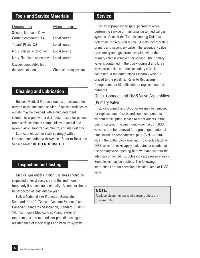Page 995 - Med Plaza and Cancer Center
P. 995
Tools and Service Materials Service
Description Manufacturer Notify appropriate hospital personnel when
Silicone lubricant, Dow performing service or maintenance to medical gas
Corning compound #4 Local source systems. Consult the Troubleshooting Guide to
determine the required repair. Outlets incorporate a
®
Truarc Pliers .038 Local source
primary and secondary valve. The secondary valve
No. 2 Phillips screwdriver Local source
prevents system gas from escaping when the
No. 2 Flat blade screwdriver Local source primary valve is removed for service. The primary
Oxygen compatible leak valve is contained in the quick-connect and DISS
detector solution Sherlock or equivalent valve assemblies and the secondary valve is
contained in the outlet block assembly which is
brazed to the pipeline. Refer to Replacement
Components for identification of replacement part
Cleaning and Lubrication numbers.
Quick-Connect and DISS Valve Assemblies
Beacon Medical Products outlets are cleaned for (Primary Valve)
oxygen or the indicated service. Exposed surfaces of Quick-connect and DISS valves may be removed
outlets may be cleaned with a mild detergent for replacement of seals and some components
solution or wiped with a disinfectant used for patient
without interrupting service to other outlets in the
room surfaces that is compatible with acetal and piping system. If vacuum quick-connect or DISS
nylon plastic, anodized aluminum, and die cast zinc. valves are to be removed for a prolonged period of
Lubricate elastomer seals sparingly with a
time, install a secondary seal plug (P/N 6-836843-
lubricant compatible with oxygen. Refer to Tools and PG) in the outlet block opening. To check a latch or
Service Materials. DO NOT USE OIL. DISS valve for leaks, apply leak detector solution at
the primary valve opening both with and without the
adapter connected. Bubbles indicate pressure leaks.
Some leaks may be audible. The following
Inspection and Testing
instructions are for servicing a leaking latch or DISS
valve.
Medical gas outlets in high use areas should be
inspected at least every six months and more
frequently if outlets are used daily. All outlets should
be inspected at least once a year. NOTE:
Follow National Fire Protection Association Replace elastomer seals whenever outlets are
disassembled.
Standard 99, 99C “Gas and Vacuum Systems,” and
Canadian Standards Association, Standard Z 305.1
“Nonflammable Medical Gas Piping Systems”
requirements and methods for periodic testing and
maintenance of medical gas and vacuum systems.
4 Part No. 847036-00 Rev. D

